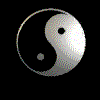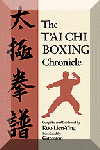


Also a
Spanish edition
The
Guang P'ing
T’ai Chi Page

Small Articles
1.
The following is an article translated from Chinese about the famous master Wang Ch'iao Yu. There are many legends about this man but this article does not seem exaggerated:
Facts from the inception of the National Party
Esteemed T’ai Chi boxing master – Wang Ch’iao Yu
T’ai Chi master Wang Ch’iao Yu was born in 1836. During the latter Ch’ing dynasty, Yang Lu Ch’an was hired to teach the sixty- four movement style of T’ai Chi to Dai Ch’i the brother of the emperor. When Yang Lu Ch’an and Dai Ch’I practiced, Wang Ch’iao Yu also practiced with them on the side as he was not of noble class. Many years later, Ch’iao Yu got the essence of the entire Yang 64 movement system. After Lu Ch’an died, the emperor’s brother was very surprised when Yang Pan Hou broke the rules of the cast system and allowed Ch’iao Yu to be a formal student and accepted into the Yang school.
T’ai Chi should be flexible and grounded. The soft and hard are combined to attain it’s function. Ch’iao Yu felt that the virtue of persistence was the most valuable aspect of practice and produced the best result. Before the age of 54 it is best to practice for strength and flexibility and using weapons. After the age of 54, one should focus the practice on the internal and spirit to learn self control and calmness. Then the internal and external then melt together to create the perfect person. Naturally, this will prolong one’s life span.
After Ch’iao Yu was 64, he began the practice of meditation and breathing. He sat for long periods of time at a temple practicing his meditation skill and only ate once a day with no feeling of hunger. In the 1930’s he was almost 100 years old yet still performed the sword and staff for many people. He had a long silver beard and a powerful spirit. It is recalled that he practiced on the snow with the red silk sword tassel contrasting the white and the reflection of the sun in the blade caused people to feel astonished.
Near the end of his life he was taken by his students to Pei Ching and given very comfortable accomodations. Every day in his late years, he was generous in aiding the needy people and helped people who were troubled or sick. People called him humble and kind. He live to the age of one hundred and three and died of a respiratory problem. His best student was Fan P’ei Cheng. Also, some famous Chinese doctors were his students. His spirit lives with us today.
![]()
2.
A Study of T'ai Chi Push-Hands - A very well thought out article about the details of the theories and principles as applies to Push Hands.
![]()
3.
Luo Ji-Hong - A wonderful chronicle of a man's search to understand the T'ai Chi principles.
![]()
4. Translated from Chinese article
The T’ai Chi Sword
The T’ai Chi sword is commonly called the thirteen style sword. It was passed down by Yang Lu Chan of Guang P’ing. The sword system had no known name before Yang Lu Chan. Another style that appeared around 1910 was called the Ch’i Men Thirteen sword that was spread from Hu Pei to Shan Tung by Ho Ch’iao Shan at Shan Tung’s Tung P’ing province. That style was almost identical to the original Thirteen style and combined the hard and soft in the same manner. Some people say that the both styles come from Yu Yang ‘s Nine Knives set.
1. Chou |
Drawing in |
| 2. Dai | To lead the way by sticking |
| 3. T’i | Rising |
| 4. Ke | Block |
|
5. Chi |
Strike, hit |
| 6. La | Stab |
| 7. Tien | Point |
| 8. Peng | Hit hard |
| 9. Chiao | Twist |
| 10. Ya | Close in |
| 11. P’i | Chop, split |
| 12. Ch’ieh | Divide, slice |
| 13. Hsien | Horizontal defense |
In this style of sword Yang Cheng Fu’s set had very few jumps but the same style by Miao Lien who was a Buddhist monk had many high jumps in the set. The monk Miao Lien was the top student of Shao Hou.
In
the practice of the sword it is very important to learn how to hold it properly
and to study in detail each of the thirteen elements and the steps that
accompany them. For instance, most
of the thirteen elements can be clearly divided into a movement but some
elements require two movements to complete.
One must know the structure of each element and its use. In learning the sword, it is most important to know your own
weapon. Then use one’s body
strength to control the weapon. Only
after that can one focus on using one’s mind.
This is the goal in practicing the sword.
It has little to do with the fanciness of the form.
![]()